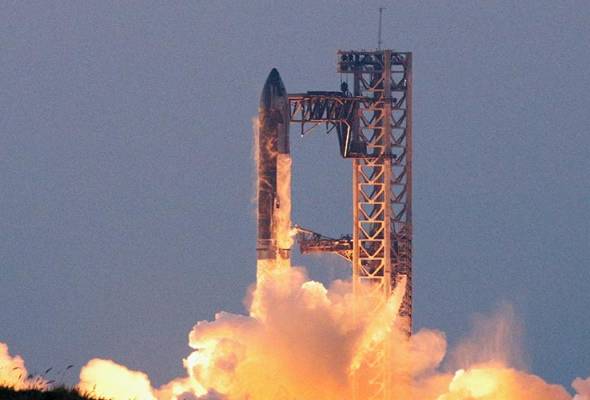October 13, 2024, will forever be remembered as the day SpaceX pulled off one of its most daring feats yet. For the first time, the company successfully caught its colossal Super Heavy Starship rocket booster—using none other than the robotic arms of its Mechazilla launch tower.
These arms, playfully nicknamed “Chopsticks,” reached out and grabbed the returning booster with jaw-dropping precision at SpaceX’s Starbase in South Texas. It was a game-changing moment in SpaceX’s quest to make space travel fully reusable.
Source: moneycontrol
Starship Rocket: The Flight that Made History
The countdown began early that morning, with Starship’s fifth test flight lifting off at exactly 8:25 a.m. EDT (1225 GMT). The rocket soared into the sky from SpaceX’s Boca Chica, Texas, facility, standing a towering 400 feet tall (that’s about 122 meters!).
While it was technically Starship’s fifth launch, this flight wasn’t just about getting it into space. This time, the challenge was to not only launch but also catch and recover the booster—a vital piece of the puzzle for SpaceX’s goal of reusability.
At the heart of this mission was the Super Heavy booster, which is massive by any standard—it’s the biggest and most powerful rocket booster ever built. Its job? To propel Starship’s upper stage into orbit and then make its way back to Earth for recovery and reuse, which is essential for cutting down launch costs. SpaceX has mastered landing boosters with its Falcon 9 rockets, but this was a whole new level of ambition.
Source: theguardian
A Perfect Catch with ‘Chopsticks’
Approximately seven minutes after liftoff, the Super Heavy booster performed a controlled descent back to Earth. As the booster approached the Mechazilla launch tower, three of its Raptor engines reignited to slow its descent. The massive rocket hovered over the tower before being precisely caught by two giant robotic arms—the “Chopsticks”—which were designed specifically for this purpose.
The landing was nothing short of spectacular. It was the first time SpaceX had attempted such a maneuver, and it was executed flawlessly. “This is a day for the engineering history books,” exclaimed Kate Tice, SpaceX’s Manager of Quality Systems Engineering, during the live broadcast, as cheers erupted from the company’s headquarters in Hawthorne, California.
The booster catch was met with jubilation, with SpaceX employees and fans worldwide celebrating the engineering marvel. Dan Huot, a SpaceX spokesperson at the launch site, expressed his astonishment: “Even in this day and age, what we just saw—looked like magic.”
Breaking New Ground in Spaceflight
Catching the Super Heavy booster with the launch tower’s robotic arms represents a significant step forward for SpaceX’s goal of fully reusable spaceflight. The ability to recover the booster in this manner reduces the turnaround time between launches, slashing costs and increasing the frequency of missions. According to SpaceX founder and CEO Elon Musk, this innovation is critical for the company’s long-term plans of enabling human exploration of the moon and Mars.
Musk took to X (formerly Twitter) after the successful landing, stating, “A Big step towards making life multi-planetary was made today.” The achievement underscores SpaceX’s commitment to revolutionizing space travel and enabling humanity’s future in deep space exploration.
Source: BBC
Starship Rocket Upper Stage Test Flight
While the starship rocket booster landing stole the show, it wasn’t the only notable part of the mission. The upper stage of Starship, which is 165 feet (50 meters) tall, continued its journey after separating from the Super Heavy booster. The upper stage—simply called “Ship”—reached an altitude of nearly 90 miles (145 kilometers) and orbited the Earth at a speed of 17,000 mph (27,358 kph).
The Ship performed a test flight aimed at reaching space before a planned splashdown in the Indian Ocean. As it began re-entering the Earth’s atmosphere, the vehicle’s advanced heat shield—made from 18,000 thermal tiles—protected it from the intense heat of re-entry. The Starship’s heat shield had undergone significant upgrades since its last flight in June 2024, addressing previous issues that caused damage during re-entry.
Although the goal wasn’t to recover the upper stage this time, the test was still a success. The Ship splashed down on target in the Indian Ocean. Shortly after, the vehicle exploded in a massive fireball, but this was not unexpected. “That was amazing,” Tice noted. “We were not intending to recover any of Starship, so that was the best ending we could have hoped for.” The explosion marked the end of the upper stage’s test mission, as engineers collected valuable data to continue improving the vehicle.
The Vision for Space Exploration
SpaceX has been clear about its long-term ambitions with the Starship rocket vehicle. Starship is designed to be the most powerful and fully reusable rocket system in history, with the potential to reduce the cost of space travel drastically. With this cost reduction, Musk envisions the possibility of frequent missions to the moon, Mars, and beyond, enabling the settlement of other planets and the expansion of humanity into the solar system.
NASA has already demonstrated its faith in SpaceX’s vision. The agency selected Starship to be the first crewed lander for the Artemis program, which aims to return astronauts to the lunar surface by 2026. Starship will play a critical role in the Artemis 3 mission, which could see the first human moon landing since Apollo 17 in 1972.
Source: BBC
The Road to Success: Not Without a Few Bumps
As exciting as the fifth flight was, it didn’t come easy. SpaceX was ready to go as early as August 2024, but the company faced delays while waiting for approval from the Federal Aviation Administration (FAA). The launch was held up for two months, which left SpaceX pretty frustrated. The company didn’t hold back, criticizing the FAA’s lengthy approval process, claiming that it was slowing down innovation and putting America’s leadership in space at risk. The red tape even included an environmental review that SpaceX argued was unnecessary for this flight.
But if there’s one thing SpaceX is known for, it’s perseverance. Their approach to rocket design is all about rapid testing, learning from every flight, and making improvements along the way. Flight 5 will undoubtedly serve as a springboard for even better results in the future.
Looking Ahead
With the successful recovery of the Super Heavy starship rocket booster and the completion of the upper stage’s test flight, SpaceX has taken another major step toward achieving its ambitious goals. The company plans to conduct more test flights in the near future, each one refining the design and capabilities of Starship.
NASA’s Artemis 3 mission may be the immediate focus, but SpaceX is thinking far beyond. Musk envisions a future where Starship routinely ferries humans, cargo, and scientific equipment to the moon, Mars, and other destinations in the solar system. This future may not be as distant as it once seemed.
As Chris Hadfield, a former Canadian astronaut, stated after witnessing the historic catch: “There was an enormous step forward in human capability today. It makes me even more excited for our collective future.”
With its reusable design, unmatched power, and innovative recovery techniques, SpaceX’s Starship may indeed hold the key to unlocking humanity’s next great chapter in space exploration.





Leave a Comment